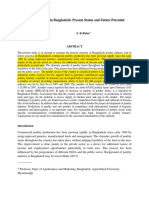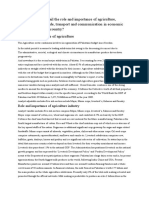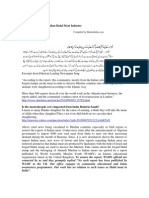Livestock: Animal Husbandry in Pakistan
Livestock: Animal Husbandry in Pakistan
Uploaded by
k.shaikhCopyright:
Available Formats
Livestock: Animal Husbandry in Pakistan
Livestock: Animal Husbandry in Pakistan
Uploaded by
k.shaikhOriginal Description:
Original Title
Copyright
Available Formats
Share this document
Did you find this document useful?
Is this content inappropriate?
Copyright:
Available Formats
Livestock: Animal Husbandry in Pakistan
Livestock: Animal Husbandry in Pakistan
Uploaded by
k.shaikhCopyright:
Available Formats
Livestock[edit]
Main article: Animal husbandry in Pakistan According to the Economic Survey of Pakistan, the livestock sector contributes about half of the value added in the agriculture sector, amounting to nearly 11 per cent of Pakistan's GDP, which is more than the crop sector. The leading daily newspaper Jang reports that the national herd consists of 24.2 million cattle, 26.3 million buffaloes, 24.9 million sheep, 56.7 million goats and 0.8 million camels. In addition to these there is a vibrant poultry sector in the country with more than 530 million birds produced annually. These animals produce 29.472 million tons of milk (making Pakistan the 4th largest producer of milk in the world), 1.115 million tons of beef, 0.740 million tons of mutton, 0.416 million tons of poultry meat, 8.528 billion eggs, 40.2 thousand tons of wool, 21.5 thousand tons of hair and [12] 51.2 million skins and hides. The Food and Agriculture Organization reported in June 2006 that in Pakistan, government initiatives are [13] being undertaken to modernize milk collection and to improve milk and milk product storage capacity. The Federal Bureau of Statistics provisionally valued this sector at Rs.758,470 million in 2005 thus [9][dead link] registering over 70% growth since 2000.
[11]
Livestock sector in Pakistan: Recent trends and progress By Technology Times at September 18, 2012 | 4:51 pm |PrintA- Reset A+
Farhan Ali & Dr M Jassar Aftab LIVESTOCK SECTOR occupies a unique position in the socio-economic development of Pakistan. It also plays an important role in the rural economy as supplementing family incomes and generating gainful employment in the rural population, particularly among the landless labourers, small and marginal farmers and women. About 30-35 million rural population is engaged in livestock raising, having household holdings of 2-3 cattle/buffalo and 5-6 sheep/goat per family which help them to drive 30-40 per cent of their income from livestock. Dairy, meat and poultry sector is a considerable major sector of livestock. Livestock contributes approximately 55.1 per cent to the agriculture value added and 11.6 per cent to the national GDP during 2010-12. Gross Value Added of the livestock sector at constant factor cost has increased from Rs 672 billion (2010-11) to Rs 700 billion (2011-12) showing an increase of 4.0 per cent as compared to previous year. Livestock population in Pakistan
In Pakistan, livestock includes cattle, buffalo, sheep, goat, camel, horses, asses and mules. Buffalo breeds found in Pakistan are Nili Ravi, Kundi and Aza Kheli. Nili Ravi is considered the best buffalo breed in the world and known as Black Gold of Pakistan. The cattle breeds found in the country are Sahiwal, Cholistani, Red Sindhi, Achai, Bhagnari, Dajal, Dhanni, Gibrali, Kankraj, Lohani, Rojhan, and Thari. Out of these, Sahiwal, Cholistani, and Red Sindhi are main dairy breeds and well known internationally due to their distinct characteristics. Goat is considered as `poor mans cow. Some rural and urban people keep goats and sheep and use their milk for domestic consumption. Role of poultry sector in livestock economy Poultry is the second largest industry of Pakistan. This sector generates employment (direct/indirect) and income for about 1.5 million people. The poultry sector is one of the most organized and vibrant segments of the agriculture industry of the country. Its contribution in agriculture and livestock is 6.4 per cent and 11.5 per cent respectively. Poultry meat contributes 28.5 per cent of the total meat production in country. Poultry sector includes domestic/rural and commercial poultry. In domestic poultry include cocks, hens, chicken, and their products i.e. eggs and meat. Commercial poultry include layers, broilers, and their products i.e. egg and meat. Meat, wool, hair, bones, fat, blood eggs, hides and skins are the main livestock products. When the horns are properly handled and processed, they provide a variety of practical and decorative articles including buttons, toggles, combs, spoons, forks, knife handles, napkin rings, wall decoration, shoes, horns, etc. The hide of animal is an important item both for export and for local industry. Pakistan is one of the worlds largest producers of good quality hides and skins, and about a million of animals are slaughtered annually. Leather is considered to be the most important raw material in the countrys economy. Faces tremendously used as fuel and organic fertilizer by the rural people. Milk: Pakistan is fourth largest milk producing country in the world. Milk is produced by buffalo, cattle, sheep, goat and camel but being major contributor in milk production, cattle and buffalo are considered major dairy animals. Milk is favorite food in Pakistan and is consumed as fresh, boiled, powdered and in processed form as yogurt, ghee, lassi, butter, cheese, ice cream, sweets and in other confectioneries. Meat: Meat industry in Pakistan is developing these days. The export of meat (beef, mutton, and camel) has increased from $ 108.54 million (2010-11) to $123.61 million in 2011-12 showing an increase of 13.9 per cent. We can fulfil the ever increasing meat demand inside the country and can earn a handful foreign exchange by exporting the meat as free of disease. Dairy animals are also used as beef animals. When a dairy animal has spent her productive life and becomes uneconomical for milk production then she is used as a beef animal. Male calves of dairy animals and dairy bulls when no further required for breeding purposes are also utilized for beef purposes.
Fisheries sector Fisheries is a sub sector that plays a significant role in the national economy and towards the food security of the country as it relax the existing pressure on mutton, beef and poultry meat. Fisheries share in GDP is 0.3 per cent. Although the contribution is very small, it adds substantially to the national income via export earnings. A total of 84,498 million tons of fish and fish products were exported 2011-12 in Pakistan and major buyers are China, Thailand, Malaysia, Middle East, Sri Lanka, and Japan.
Pakistan is ranked 19th in terms of meat production with an annual output of 2.2 million tons. In the three-trillion-dollar halal product industry of the world, the meat segment is worth $600 billion. Pakistans share in it is only $115 million. He believed that total meat exports of the country could reach $500 million if the government started taking interest in this industry. Citing the example of India, he claimed that the neighbouring country, which is not even an Islamic state, was exporting halal meat worth $23 billion annually just by properly organising the industry. He highlighted smuggling of live animals to Afghanistan and Iran as another problem that has been hitting the livestock market. According to Pamco, around 2.5 million live animals worth $1.4 billion are smuggled every year, dealing a damaging blow not only to domestic meat sales, but also to exports. Saifi stressed that if smuggling was brought under control, the export of red meat would grow and prices would also come down in the country. This will also provide a boost to the local leather and tannin industry which will have access to high quality hides at lower cost. In fact it has been a long-standing demand of the local leather industry to limit livestock exports and to promote meat exports.
Lahore, June 24, 2013 (PPI-OT): Halal meat market is growing rapidly throughout the world and its demand is increasing day by bay, Pakistan ranked 18th in the production of Halal Meat Market and its volume is only 2.9 % of the global Halal meat production which is very low, These views were expressed by Muhammad Zubair Mughal, Chief Executive Officer-Halal Research Council, he mentioned that Pakistan can play pivotal role in this growing market because Pakistan have more than 160 million quality live stock including 71 million Cattles and Buffalos and 89 million goats and sheeps. -
You might also like
- LivestockDocument26 pagesLivestockMuhammad Jawad KhanNo ratings yet
- SANAULLAHEconomic Analysis of Poultry Production in Tando Allahyar, Sindh Economic Analysis of Poultry ProductionDocument14 pagesSANAULLAHEconomic Analysis of Poultry Production in Tando Allahyar, Sindh Economic Analysis of Poultry ProductionSanaullah NoonariNo ratings yet
- Meat Supply ChainDocument9 pagesMeat Supply ChainAly BhamaniNo ratings yet
- Farrukh LMDocument3 pagesFarrukh LMSajid AslamNo ratings yet
- Livestock and PoultryDocument2 pagesLivestock and Poultryjas roveloNo ratings yet
- Livestock Business BoostsDocument3 pagesLivestock Business BoostsRacing SangersNo ratings yet
- Meat and Meat Industry in IndiaDocument4 pagesMeat and Meat Industry in Indiashanaya talatiNo ratings yet
- Enrichment of Egg ExportDocument6 pagesEnrichment of Egg ExportIndumathiNo ratings yet
- Livestock Resources of PakistanDocument14 pagesLivestock Resources of PakistanAdil Khan100% (1)
- 084Document12 pages084Fahad MahadiNo ratings yet
- Strategy & Strategic PlanDocument45 pagesStrategy & Strategic PlanSatish Chandra TiyuNo ratings yet
- Print Article 1Document15 pagesPrint Article 1Ayezah MughalNo ratings yet
- Animal FeedsDocument3 pagesAnimal FeedsKrishnakumar KNo ratings yet
- Indian Poultry ScenarioDocument54 pagesIndian Poultry ScenarioSagar J. ChavanNo ratings yet
- Indian Poultry and Its Future ProspectsDocument13 pagesIndian Poultry and Its Future Prospectssalil4mbaNo ratings yet
- Industry AnalysisDocument4 pagesIndustry AnalysisnaumansajidNo ratings yet
- poultry pathologyDocument19 pagespoultry pathologyonthkapadNo ratings yet
- The Role of the Poultry Sector in the Economy of PakistanDocument4 pagesThe Role of the Poultry Sector in the Economy of Pakistantituchampion22222No ratings yet
- Comparison Between Bovine and Buffalo Milk Yield in PakistanDocument10 pagesComparison Between Bovine and Buffalo Milk Yield in PakistanAbdullah AhmedNo ratings yet
- Anwar SBDocument19 pagesAnwar SBAdeel AshiqNo ratings yet
- LPM 6 .2 NotesDocument98 pagesLPM 6 .2 Notesmayanmendpara27No ratings yet
- Goat Farming Notes For ProjDocument25 pagesGoat Farming Notes For ProjAngelinaNo ratings yet
- 1.2 Regional Variation in Poultry DevelopmentDocument3 pages1.2 Regional Variation in Poultry DevelopmentHarshad JainNo ratings yet
- Q. 1 Discuss in Detail The Role and Importance of Agriculture, Industry, Foreign Trade, Transport and Communication in Economic Development of The Country? Role and Importance of AgricultureDocument2 pagesQ. 1 Discuss in Detail The Role and Importance of Agriculture, Industry, Foreign Trade, Transport and Communication in Economic Development of The Country? Role and Importance of AgricultureShaista HassanNo ratings yet
- The Black Bengal Goat As A Tool To Promote Sustainable Livelihoods in Rural West BengalDocument13 pagesThe Black Bengal Goat As A Tool To Promote Sustainable Livelihoods in Rural West BengalMUHAMMAD ARIFNo ratings yet
- Export of Live Animals From PakistanDocument16 pagesExport of Live Animals From PakistanŘabbîâ Khan0% (1)
- Dairy Farming Sector in Sri LankaDocument20 pagesDairy Farming Sector in Sri LankaCaleska Agritech100% (3)
- Livestock IndiaDocument8 pagesLivestock Indiak.shaikhNo ratings yet
- Hoticulture 2Document20 pagesHoticulture 2Alishba SherazNo ratings yet
- Environmentally Controlled Dairy Farm (100 Holstein Cows - American)Document23 pagesEnvironmentally Controlled Dairy Farm (100 Holstein Cows - American)dahaf2023No ratings yet
- SHEEP and Goat FARMING in PakistanDocument29 pagesSHEEP and Goat FARMING in PakistanSaeed Malik0% (1)
- Dairy IndustryDocument19 pagesDairy IndustryMoeenuddin HashimNo ratings yet
- Supply Chain of Mutton in Malaysia - Challenges and The Way ForwardDocument9 pagesSupply Chain of Mutton in Malaysia - Challenges and The Way ForwardJunidi DoronsoiNo ratings yet
- Export Market A Project Report ONDocument25 pagesExport Market A Project Report ONrahul_bba4No ratings yet
- Livestock Prod. in RajasthanDocument7 pagesLivestock Prod. in RajasthansimivprakashNo ratings yet
- International Egg and Poultry Review: Pakistan: NpcpaiDocument2 pagesInternational Egg and Poultry Review: Pakistan: Npcpaiwaqasfarooq75_396423No ratings yet
- Poultry Industry in IndiaDocument8 pagesPoultry Industry in IndiaDivya Sasi100% (1)
- Muhammad Hadi Jassar Farms PresentationDocument22 pagesMuhammad Hadi Jassar Farms PresentationAlHuda Centre of Islamic Banking & Economics (CIBE)100% (1)
- Economics of Animal Rearing in India by AmarnathDocument5 pagesEconomics of Animal Rearing in India by AmarnathAmar NathNo ratings yet
- India HalalDocument4 pagesIndia HalalHalal IndiaNo ratings yet
- Poultry PathologyDocument19 pagesPoultry PathologyonthkapadNo ratings yet
- Feedlot OperationsDocument6 pagesFeedlot OperationsNesru HusseinNo ratings yet
- Livestockproject 200426124028Document27 pagesLivestockproject 200426124028naharpurab09No ratings yet
- ANIMAL HUSBANDARY AND DairyingDocument231 pagesANIMAL HUSBANDARY AND DairyingVishal KushwahNo ratings yet
- Comparison Between Bovine and Buffalo Milk Yield in PakistanDocument9 pagesComparison Between Bovine and Buffalo Milk Yield in PakistanMasood HassanNo ratings yet
- What Do You Know About Stock, Poultry and Fishing in Pakistan?Document2 pagesWhat Do You Know About Stock, Poultry and Fishing in Pakistan?drezyNo ratings yet
- India Livestock ReportDocument9 pagesIndia Livestock Reportgoyal.rohit8089No ratings yet
- Malaysia's Beef Cattle IndustryDocument21 pagesMalaysia's Beef Cattle IndustrySaipolNo ratings yet
- LESSON 1 Indian Poultry Industry - Brief ViewDocument6 pagesLESSON 1 Indian Poultry Industry - Brief ViewTusharNo ratings yet
- Animal AssignmentDocument7 pagesAnimal Assignmentshristikhanal32No ratings yet
- Installment AllDocument41 pagesInstallment AllJasmer BooraNo ratings yet
- The Indian Feed IndustryDocument20 pagesThe Indian Feed IndustrySriram Vattikuti100% (1)
- Chapter - Iii: The Trends in The Dairy IndustryDocument64 pagesChapter - Iii: The Trends in The Dairy IndustryrashmiNo ratings yet
- Role of Livestock in Indian EconomyDocument6 pagesRole of Livestock in Indian EconomyaftabkhansNo ratings yet
- A Report of Livestock Industry of IndiaDocument16 pagesA Report of Livestock Industry of IndiaGrowel Agrovet Private Limited.No ratings yet
- Fodder Production and Trading CompanyDocument28 pagesFodder Production and Trading Companyimran100% (1)
- An Overview of Poultry Production in India: R.N. Chatterjee and U. RajkumarDocument21 pagesAn Overview of Poultry Production in India: R.N. Chatterjee and U. RajkumarSp SeerviNo ratings yet
- Beef Cattle Management - With Information on Selection, Care, Breeding and Fattening of Beef Cows and BullsFrom EverandBeef Cattle Management - With Information on Selection, Care, Breeding and Fattening of Beef Cows and BullsNo ratings yet
- Steel Imports To HitDocument2 pagesSteel Imports To Hitk.shaikhNo ratings yet
- Issues That I Have Analyzed and Faced During My Internship PeriodDocument2 pagesIssues That I Have Analyzed and Faced During My Internship Periodk.shaikhNo ratings yet
- Ahmed Salam Sahito: Objective StatementDocument2 pagesAhmed Salam Sahito: Objective Statementk.shaikhNo ratings yet
- Diagnosis October 2010 v1Document5 pagesDiagnosis October 2010 v1k.shaikhNo ratings yet
- FRM Schedule Starting 2 November 2011 2 NovDocument1 pageFRM Schedule Starting 2 November 2011 2 Novk.shaikhNo ratings yet
- Umair Alam ResumeDocument2 pagesUmair Alam Resumek.shaikhNo ratings yet
- Important Mcqs Regarding Nts TestsDocument129 pagesImportant Mcqs Regarding Nts Testsk.shaikh100% (3)
- 5.6 A) Actual Exchange Rate B1 + B2 (Xi) + Ui Actual Exchange RateDocument1 page5.6 A) Actual Exchange Rate B1 + B2 (Xi) + Ui Actual Exchange Ratek.shaikhNo ratings yet
- Poblem 3.19 &interpretations of Other ProblemsDocument1 pagePoblem 3.19 &interpretations of Other Problemsk.shaikhNo ratings yet
- Introduction To Microeconomics - Quiz 1Document6 pagesIntroduction To Microeconomics - Quiz 1k.shaikhNo ratings yet
- Movies Summary and BATNA HANDOUTDocument3 pagesMovies Summary and BATNA HANDOUTk.shaikhNo ratings yet
- Sample Paper - Strategic Human Resource ManagementDocument22 pagesSample Paper - Strategic Human Resource ManagementDark HavocNo ratings yet
- Livestock IndiaDocument8 pagesLivestock Indiak.shaikhNo ratings yet
- EssayDocument2 pagesEssayk.shaikhNo ratings yet
- Procurement vs. PurchasingDocument4 pagesProcurement vs. Purchasingk.shaikhNo ratings yet
- Asian Fin Crisis 1997 Write-UpDocument13 pagesAsian Fin Crisis 1997 Write-Upk.shaikhNo ratings yet
- Trade Digitization and Cat 7 EnhancementsDocument86 pagesTrade Digitization and Cat 7 EnhancementsadnanbwNo ratings yet
- Actividad 29 Software para Realizar Un Plan de Negocios.Document15 pagesActividad 29 Software para Realizar Un Plan de Negocios.Juan Manuel Martinez EnriquezNo ratings yet
- CIR V DE LARADocument3 pagesCIR V DE LARAiptrinidad100% (1)
- Augmont Goldtech Private Limited: 24K 999 GoldDocument1 pageAugmont Goldtech Private Limited: 24K 999 GoldMallesh ReguNo ratings yet
- Economics 100 AssignmentDocument15 pagesEconomics 100 AssignmentHaris ANo ratings yet
- Payout PolicyDocument117 pagesPayout PolicyPeggy PengNo ratings yet
- Chapter 9 Online Retail and ServicesDocument37 pagesChapter 9 Online Retail and Servicesjdphan100% (1)
- EY Report On Private Credit MarketDocument18 pagesEY Report On Private Credit MarketSaranNo ratings yet
- The Accounting Equation and Financial StatementsDocument30 pagesThe Accounting Equation and Financial StatementsAlya CandyNo ratings yet
- All Exam in 2016-2017 From Test BankDocument3 pagesAll Exam in 2016-2017 From Test BankHamza JalalNo ratings yet
- Hayleys PLC AR 2021 22Document476 pagesHayleys PLC AR 2021 22Hashini ChamodikaNo ratings yet
- Financial Accounting - Iitmandi: Prof. Puran SinghDocument910 pagesFinancial Accounting - Iitmandi: Prof. Puran SinghAniket JupiterNo ratings yet
- AGBS MBA Syllabus 4th SemDocument29 pagesAGBS MBA Syllabus 4th SemrenjumvNo ratings yet
- Tax Invoice: Datum TechnologiesDocument1 pageTax Invoice: Datum Technologiesraj rajNo ratings yet
- Busniess 2nd PucDocument79 pagesBusniess 2nd PucBindu ShreeNo ratings yet
- M SC Construction Management 2013 1Document1 pageM SC Construction Management 2013 1Mohan Babu YadavNo ratings yet
- Section D AnswersDocument34 pagesSection D AnswersmostafanourallahNo ratings yet
- Forage - Task 1 - Virtual Presentation (10237404872.17) - FinalDocument25 pagesForage - Task 1 - Virtual Presentation (10237404872.17) - FinalMinh Hoàng 2001 NguyễnNo ratings yet
- CITIES, TOWNS, AND SUBURBS: Local Goverment in A Time of Peak Oil and Climate Change by John KaufmannDocument11 pagesCITIES, TOWNS, AND SUBURBS: Local Goverment in A Time of Peak Oil and Climate Change by John KaufmannPost Carbon InstituteNo ratings yet
- A Study of Different Corporate Social Responsibility Activities by Tata Group in IndiaDocument48 pagesA Study of Different Corporate Social Responsibility Activities by Tata Group in IndiaJenny VermaNo ratings yet
- Business Policy: Ish Verma 2K19/BBA/38 Section-BDocument3 pagesBusiness Policy: Ish Verma 2K19/BBA/38 Section-BIsh vermaNo ratings yet
- Week 3-Fringe Benefit TaxDocument51 pagesWeek 3-Fringe Benefit TaxMARCIAL, Althea Kate A.No ratings yet
- Financial Statement of RaymondsDocument35 pagesFinancial Statement of RaymondsKevin DoshiNo ratings yet
- Introduction To Strategic PlanningDocument3 pagesIntroduction To Strategic PlanningKanishka GuptaNo ratings yet
- Barclays The FX Quantitative AnalyzerDocument22 pagesBarclays The FX Quantitative AnalyzerCynthia SerraoNo ratings yet
- Worksheet 11Document2 pagesWorksheet 11Aira Shene60% (5)
- Exercise 1with AnswerDocument10 pagesExercise 1with AnswerMA ValdezNo ratings yet
- Servicer Contact Information 4-27-2010 UpdateDocument4 pagesServicer Contact Information 4-27-2010 UpdatesciubancaNo ratings yet
- Operations Management: William J. StevensonDocument28 pagesOperations Management: William J. Stevensonbuddhankaruson100% (7)
- A Study On Investor Preferences Towards Various Mutual FundsDocument122 pagesA Study On Investor Preferences Towards Various Mutual FundsAnkit Agarwal60% (5)








































































































